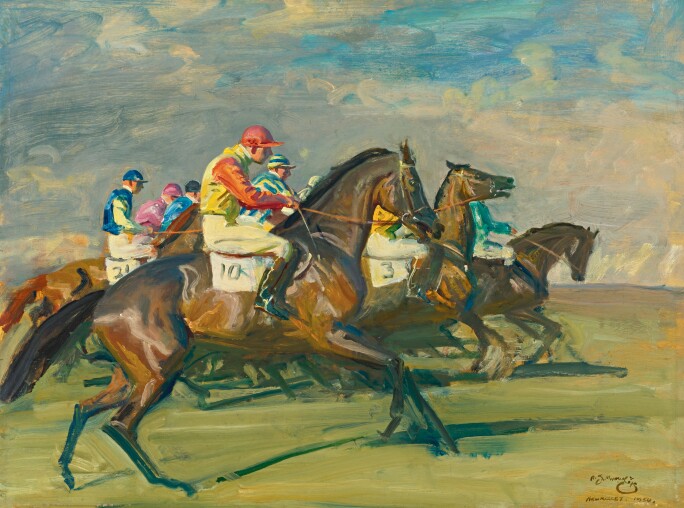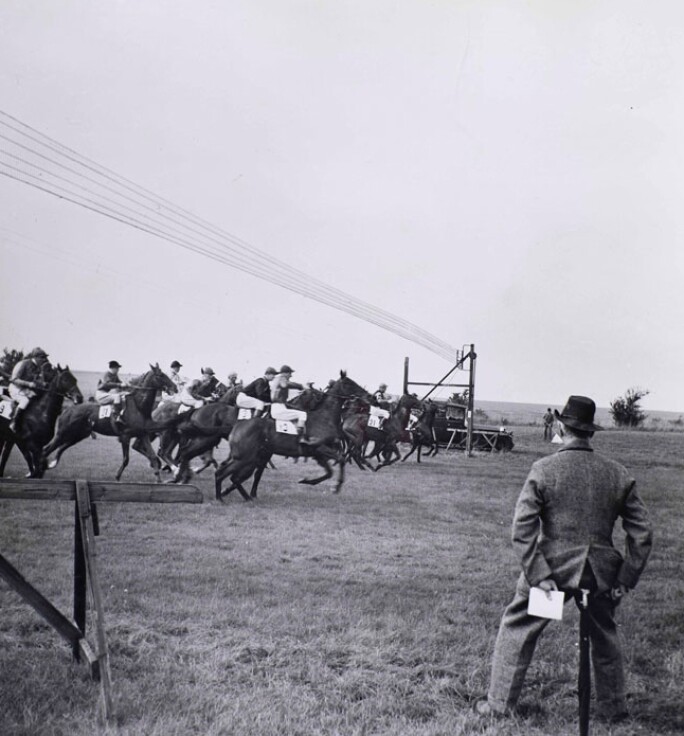‘I am standing on the course - the most beautiful course in the world... I am looking at the scene, the old, old scene - a centuries old scene. Horses come up the course looking like those of years ago.... Bright colours in the sun just the same as of yore.... What a sight for the artist! with the long shadows and the lights on the boots, lights on the horses.... This is the best picture I have ever seen...’
The Start was probably painted circa 1950 and is part of a series of pictures that Munnings painted in which he sought to capture the kinetic energy of horses in movement – the rhythmic pounding of hooves on the turf, the glistening sweat on the muscular flanks as they surge forward in unison, nostrils flared and eyes wild with the thrill of the race. Details are undefined as though we are glimpsing the horses and jockeys as they race past our view, the paint is applied with bravura and energy. Munnings has used a clever compositional trick of suggesting the action beyond the edges of the painting. To focus the viewer's attention on the field Munnings eliminates any suggestion of starter, spectator or grandstand. Using only subtle variations in the animals colouring he organises the repeat forms of the horses into a tight race line. The vibrant and starkly contrasting tones of blue, pink and yellow lead the viewer's eye in a haphazard fashion which acts as a metaphor for the action to come. This fractured composition was a device similar to Degas’ scenes of ballerinas or races, in which the focus is on the movement taking place in one scene but surging forward into empty space, their legs extending onward to suggest that there is something towards which they are moving. The flash of colour only momentarily occupies the space that we are seeing, a glimpse of fast action which is fleeting and invigorating – the thrill of the race that makes the hearts pound of all involved, horses, jockeys and spectators. This arrangement helps to convey the powerful excitement and anticipation of the scene; emotions which the artist himself always felt as a race came to order. It is a painting entirely focused on depicting forward momentum as the horses leap into movement, powerfully breaking into a gallop, all moving in the same direction but at different paces. Munnings’ fluid application of paint used to indicate the furthest jockeys and their only part-appearance convey a sense of motion and recession of space. The ground slides away and clouds are streaked across the sky as the horses and riders surge past. As Munnings wrote in his memoirs of his unerring fascination with painting horse races; ‘...to my own profession and purpose – seeing the visible beauty; the grouping, the movement – colour, all dependent on the lighting, the sky’ (Sir Alfred Munnings, The Autobiography of Sir Alfred Munnings, The Finish, Museum Press, London, 1952, p. 182).
Racing fascinated Munnings from the earliest stage of his career. He saw his first horse race in his home county of Suffolk, at Bungay. After two days watching the racing, he felt that his life had taken a different direction:
‘I saw the thoroughbred horses and jockeys in bright silk colours, going off down the course…The peaceful School of Art, the smelly artist’s room faded away, and I began to live!’

Munnings exhibited his first painting of the start of a horse race at the Royal Academy in 1915. It depicted horses lined up at the St Buryan races, awaiting the start. He included a painting of the start of a horse race in virtually every Royal Academy exhibition between 1940 and his death in 1959 and by the Second World War these subjects were the principle focus of his art. Munnings had become disillusioned with the commissions which he felt constrained and compromised his freedom and the paintings of racing allowed him to submerge himself in his true passion, painting the raw, wild energy of the horse in action. He had returned to his country house in Dedham, a mere forty or so miles from Newmarket. This gave him the opportunity to make regular visits to the racecourse throughout the season where he could take inspiration from three or four races a day. Munnings even set up a studio, courtesy of the Jockey Club, in an old rubbing barn. He frequently refers to the different Start scenes in his autobiography on which he was working at this time. He ruefully acknowledges the frustration he felt in trying to capture the unique character of each event. Photographs of Munnings in his studio from these years often show him with two or three distinctive Start scenes, along with supporting studies.

The present picture is very similar to The Start, Newmarket dated 1954 (Sotheby’s, New York, 29 November 2007, lot 113, sold for $937,000) in which the horse in the foreground is in an almost identical position. It is highly likely that the present picture was also painted at Newmarket, as were most of the racing pictures of this period in Munnings’ career. Munnings considered Newmarket racecourse to be ‘the most beautiful course in the world’, and it never failed to inspire him on his countless visits. Established in 1605 by King James I., it is one of the oldest racecourses in England, and Munnings continued in a tradition established at the start of the eighteenth century with artists like Wootton, Seymour and Stubbs. Although Munnings’ paintings at Newmarket capture a similar grandeur and celebrate equestrian beauty in a similar way to his predecessors two hundred years earlier, he was also inspired by more modern artists. Munnings had visited the Académie Julian in Paris on short trips to France in the early 1900s and it is believed that it was at this seminal time of his career that he saw and admired the work of Edgar Degas. Degas was known for his energetic and daring racing scenes, and Munnings was probably inspired not only by Degas’ choice of subject but also the bold way he depicted it. Photography was also an influence on Munnings and this may have inspired his interest in cropping scenes for greater impact. As early as 1898 when he painted Evening on the Suffolk Marshes, he used a dramatic crop for artistic effect. It was perhaps the racing scenes at Newmarket where Munnings used cropping most dramatically and it was here that he experimented with the technique.
This picture belonged to Edgar Cooper-Bland, a friend of Munnings’ and owner of a successful stud at Newmarket. He and his wife had purchased Going to the Start from Munnings’ Leicester Galleries exhibition in 1947 and told the artist when they saw him at the exhibition; ‘A.J. I always like to buy the best – I have your smaller Cheltenham picture and I am buying this.’ Some years later Munnings wrote ‘Cooper Bland has other of my works but this [Going to the Start] was too large for his room and a London dealer offered him a big profit and so he sold it. I’ve been on the phone with him just now and he says he misses it badly and is looking for a smaller one.’ (letter from Munnings to William Coxe-Wright, dated 12 December 1952) It seems that this version of The Start may have been the picture he purchased to satisfy his loss.
At Newmarket, the clerk of the course gave Munnings special permission to position his car at the starting post and he used his horse box as a portable studio from which to paint the action. He was not viewing from afar - he was painting beside the horses and the jockeys and this gives the paintings a palpable realism as he was able to feel the nervous tension and the thrill of the moment of the start. The strong compositions of his Start pictures and the sculptural qualities were consistent – he usually placed a horse and jockey in the foreground, in profile with a receding line of other riders in the distance. Munnings was less interested in the end of a race – his fascination was the tension and anticipation of action in the moments before the race or the initial surge as the race begins when the horses, jockeys and spectators erupt into a mass of energy and excitement. The present picture captures that moment beautifully. He wrote that ‘each start is a fresh picture for me, as they have been, meeting after meeting, year after year’ (Sir Alfred Munnings, The Finish, Bungay, 1952, p. 207).

Munnings’ Start paintings have always been acclaimed and popular. In 1937 Mary Chamot stated that Munnings, ‘holds the field [of sporting painting] almost alone…He is a brilliant technician, knows how to make his brush-work, as well as his colour, expressive of form, and of course he has a perfect knowledge of his subject’ (M. Chamot, Modern Painting in England, London, 1937, p. 92). Munnings continued to be fascinated by horses and in his last lectures to students at London University’s Royal Veterinary College’s Medical Association, he made this clear:
‘He told us if there were no horses in the world, life would not be worth living. He said he expressed his love for them through painting and by studying them and he never tired of looking at them…He spoke of the smell of dew at early morning gallops and the clatter of horse’s hoofs at the start of a race with the horses milling around, waiting to get under starter’s orders; a moment of tension with their nostrils flaring and their adrenaline slowing. ‘Always the start – never the finish,’ he said.’